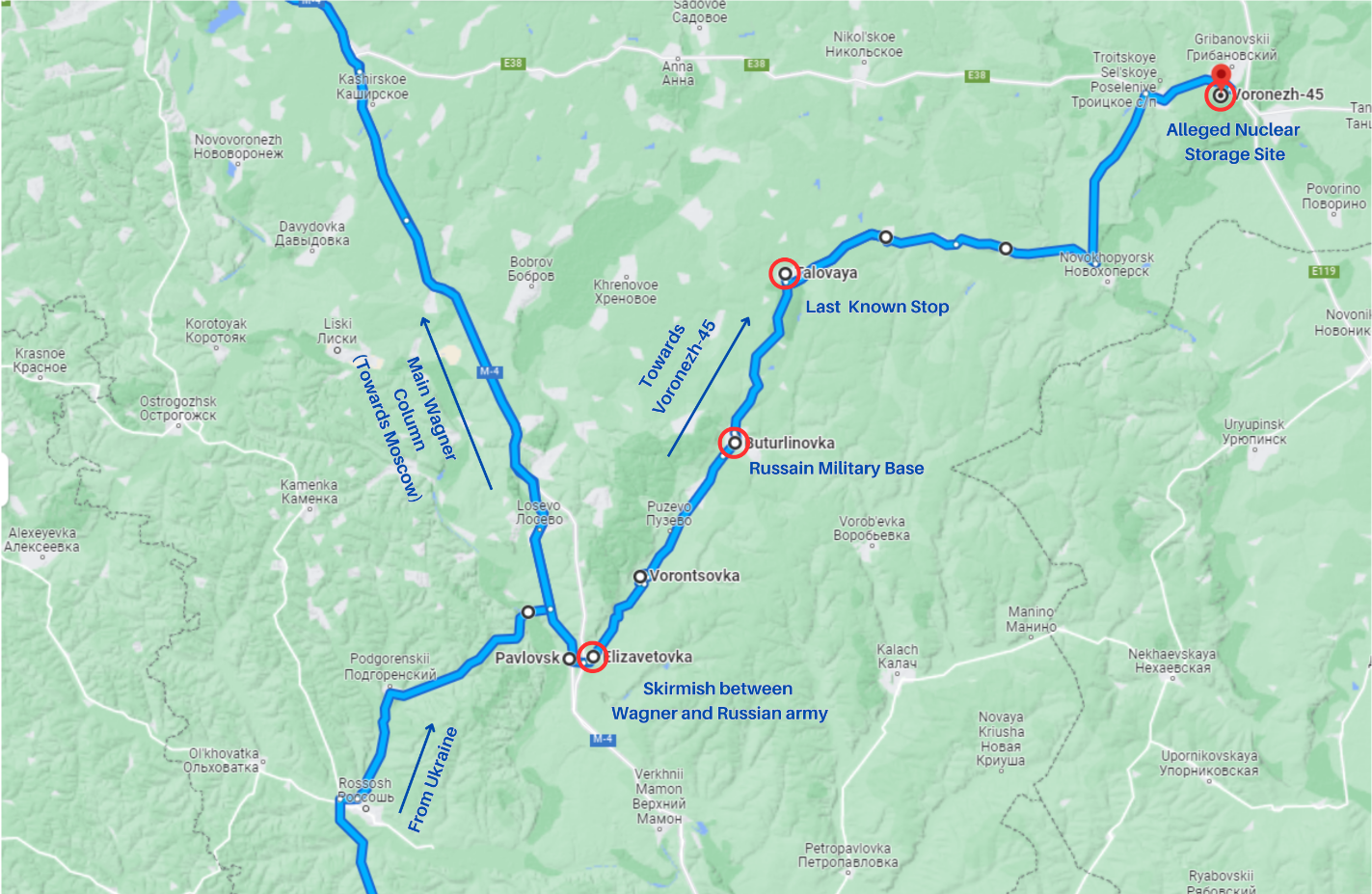In a recent development, Kyrylo Budanov, the head of Ukraine’s military intelligence, made a bold claim last week. He stated that a contingent of the Wagner group had reached Voronezh-45 on June 24th during their revolt, intending to acquire ‘tactical nukes’ stored at the site, in an attempt to “raise the stakes” between the Wagner group and the Russian state. However, Budanov failed to provide any evidence to support his claim, mentioning that the storage doors were closed, and the Wagner forces did not gain access to the technical section.
The Voronezh-45 nuclear facility is under the operation and protection of the Russian Defense Ministry’s 12th Main Directorate, entrusted with safeguarding Russia’s stockpile of nuclear weapons. While the Russian Defense Ministry’s website and publicly accessible records confirm this, the specific contents of the facility remain shrouded in secrecy. Russia has never officially acknowledged the presence of nuclear weapons at Voronezh-45, with such information only emerging through reports from foreign sources. Reports indicate that on June 24th the main column of the Wagner forces was marching northbound towards Moscow, while a contingent diverted eastward towards the Voronezh-45 base. Skirmishes with Russian troops occurred at Elizavetovka, and a Russian Army helicopter was downed at Talovaya during this movement.
Despite the lack of evidence and corroboration from allies such as the U.S., Budanov’s claim is significant due to the growing rift between Wagner Chief Yevgeny Prigozhin and the Kremlin’s Defense Minister Sergei Shoigu. Prigozhin accused Shoigu of ordering a rocket attack on Wagner’s field camps in Ukraine, where his troops were fighting on behalf of Russia. Prigozhin ordered his troops to march towards Moscow with hundreds of vehicles, tanks, armoured personnel carriers, artillery and anti-aircrafts guns seen in the videos emerging on social media as part of the convey. At Pavlovsk, the main Wagner Column continued its journey towards Moscow in the north while a small convey headed east. As per the Ukrainian chief of military intelligence, the objective of this small force was to capture few tactical nuclear weapons stored at Voronezh-45 base. Despite having a Russian military base at Buturlinovka, Wagner troops faced little resistance along the way, reaching Talovaya where they stayed until an agreement was reached between Russia and Prigozhin.
Analysing the open-source information
According to Reuters, videos and on-ground sources suggest that a faction of the main Wagner force did move eastward. Geotagging indicated the presence of at least 75 vehicles, including armored personnel carriers, ambulances, and an artillery gun towed behind a truck, on the outskirts of a town. Reuters tracked this convoy to Talovaya, which is approximately 120 km from the Voronezh-45 base. Local reports suggest that the convoy did not proceed further, and an agreement was reached between the Kremlin and Prigozhin, leading to the announcement of troop withdrawal.

Analysing the situation, the Wagner forces’ eastward movement does indicate an intention to reach Voronezh-45 since there isn’t any other significant strategic installation in the direction of this movement. However, the claim that they successfully reached the base seems far-fetched and likely part of the ongoing information warfare between Russia and Ukraine. Given its limited number of troops, supplies and without air power, it was evidently clear that Wagner could not emerge victorious after taking Kremlin head on. In case of active combat, it would have been a suicide mission for Wagner troops if the confrontation prolonged. Hence, the most plausible explanation for this eastward undertaking could have been to exert pressure on Moscow for a settlement, rather than seizing the tactical nuclear weapons.
This assessment is reinforced by, as reported by Reuters, a source close to the Kremlin. This source claimed that a Wagner contingent “managed to get into a zone of special interest, as a result of which the Americans got agitated because nuclear munitions are stored there.” This revelation caused concern in the Kremlin, leading to a hastily negotiated end to the rebellion on June 24, brokered by Belarusian President Alexander Lukashenko.
Furthermore, even if the Wagner fighters had gained access to tactical nuclear weapons, operating them would be a separate challenge altogether. Matt Korda, from the Federation of American Scientists, explained that the weapons are stored in an incomplete state and require specialized equipment and cooperation from the responsible directorate for unlocking permissive action links. Thus, the technical knowledge required makes it highly unlikely that Wagner could successfully operate the weapons.
Western double standards
The lukewarm response from Western officials regarding this news is noteworthy. White House spokesperson Adam Hodge stated that the U.S. had no indication that nuclear weapons were ever at risk. Similarly, other Western allies of Ukraine, such as the UK, Germany, and France, remained silent on the matter. This double standard raises questions about how even hypothetical incidents involving other countries, such as Pakistan, receive overwhelming attention, despite the same fundamentals of nuclear security as elaborated by Matt Korda. Even in the highly unlikely scenario of a non-state actor gaining access to Pakistan’s nuclear weapons, the operational expertise required is beyond the capabilities of a ragtag militia force.
Moreover, the ability of Wagner troops to capture military bases without resistance from Russian forces, something that never happened in Pakistan, should raise concerns about the security of nuclear weapons. It is worth considering a situation where a disgruntled group of Russian army personnel responsible for nuclear safety could have colluded with Wagner, offering technical operational assistance. Yet, this scenario received a fraction of the attention it would have garnered had it involved a country like Pakistan. It speaks volumes about the insincerity of western governments to hype up or hush down matters based on their own geopolitical interests rather than merits of the issue at hand.
Nuclear security is a serious matter that demands nuanced handling, rather than being used as a tool to enhance geopolitical agendas. As events continue to unfold, it is essential to prioritize factual evidence over unfounded claims, ensuring a balanced and informed understanding of the situation.

Be the first to comment